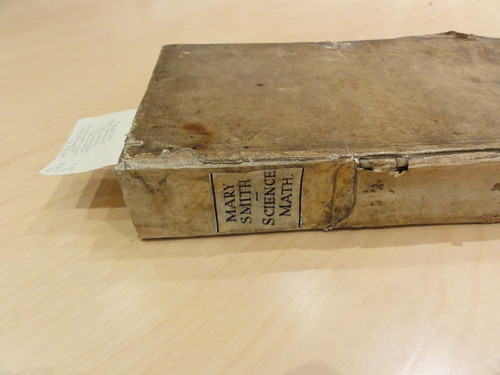Blogs across the Smithsonian will give an inside look at the Institution’s archival collections and practices during a month long blogathon in celebration of October’s American Archives Month. See additional posts from our other participating blogs, as well as related events and resources, on the Smithsonian’s Archives Month website.
 Mary Smith's "Commonplace book concerning science and mathematics"
Mary Smith's "Commonplace book concerning science and mathematics"
A couple of years ago, I saw a production of Tom Stoppard's play Arcadia. One of the central characters is Thomasina Coverly, a precocious girl in early 19th century England whose student notebooks were bursting with ideas on how to unlock the greatest mysteries of science and mathematics. I was reminded of the voracious intellect and efforts of Stoppard's Thomasina recently in the Dibner Library of the History of Science and Technology when I came across an 18th century vellum-bound volume filled with more than 300 pages of carefully handwritten notes on a wide variety of scientific themes. Arranged in two parts, the volume includes a detailed table of contents indexed with a set of hand-cut alphabetical thumb tabs, followed by hundreds of pages filled front and back with summaries of articles, experiments, and questions on science, mathematics, medicine, and religion.
The manuscript (MSS 001281 B SCDIRB) provides remarkable evidence of a lively, inquiring mind absorbing a level of information that would be impressive anywhere, but it seems particularly surprising that this volume was apparently produced by a girl or woman named Mary Smith, who resided in the remote village of Thorney, part of the Earl of Bedford's model agricultural estate in the Fens of Cambridgeshire during the 1760s and 1770s. Who was Mary Smith? She was wealthy or well-connected enough to have her own folio volume elegantly bound in vellum, and her own specially printed bookplate, shown here, consisting of an elaborate architectural design created by artfully arranged printer's ornaments. The bookplate was printed by Thomas Fletcher (fl. 1762-1779) and Francis Hodson (d. 1812), partners in Cambridge who also printed the Cambridge Chronicle, a magazine frequently cited in Smith's manuscript. Otherwise, there are almost no details in the volume that help to further identify its compiler.
According to an accession list kept in the Dibner Library, the manuscript was acquired by Bern Dibner for his Burndy Library collection of landmark works in the history of science and technology in 1958 for $40.00 from the London antiquarian book dealer Ben Weinreb. Weinreb described the manuscript as a "commonplace book relating to scientific and mathematical subjects, including notes from several 18th century books." The volume apparently was created after 1764 and continues into the 1780s, based on references cited in the text. Mary Smith's notes indicate she had access to several of the most popular periodicals of the time, including the New Universal Magazine, the London Magazine, the Philosophical Transactions, the Gentleman's Magazine, the Monthly Review, and the Universal Museum, and she frequently refers to lectures and articles sponsored by the Royal Society and the Society for the Encouragement of Arts, Manufactures, and Commerce. She was particularly interested in the latest debates over scientific theories and inventions, for example filling up several pages of notes dated 1765 summarizing contemporaneous reports about the marine chronometer invented by clock-maker John Harrison, who was awarded a prize of £10,000 from the commissioners of the British Board of Longitude.
Unfortunately, with a name as common as "Mary Smith," a search for more information about the person who kept this notebook has quickly gone cold, but perhaps one of the readers of this blog who knows more about the Smith family or the local history of Thorney will be able to supply more detail. There is a tantalizing possibility that another tome of her notes may exist somewhere, since the detailed index occasionally refers to a second volume.
With such a wealth of material ranging over a wide variety of topics, it was difficult to select just a few representative pages from Mary Smith's manuscript to show here. There are some carefully drawn diagrams in the volume, including one for the mathematical exercise of dialling (from p. 20) and an astronomical illustration (from p. 37). The page opening for p. 57-58 discusses the cause of thunder and its relationship to electricity and magnetism, citing sources ranging from the Bible (Job 28, verse 26) to Welsh mathematician William Jones to the scientific observations of Benjamin Franklin.
This blog entry was written in recognition of Ada Lovelace Day (October 7, 2011), an international initiative to highlight the contributions of women in the fields of science, technology, engineering, and mathematics. The intellectual curiosity and enthusiasm of Mary Smith is almost forgotten to time, except for this volume she left behind testifying to her love of scientific inquiry. Ada Lovelace (1815-1852), an amazing woman who corresponded with some of the most noted scientists and mathematicians of her day, is generally recognized as the first computer programmer. I hope that the stories of these two women, Ada Lovelace and Mary Smith, will inspire generations of students with their passion for learning.
— Diane Shaw, Special Collections Cataloger





Be First to Comment